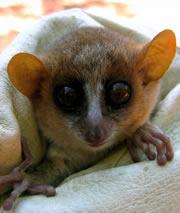 A wide-eyed mouse lemur has its DNA tested to see what species it belongs to. Click here for a slide-showUniversity of Veterinary Medicine, Hanover.
A wide-eyed mouse lemur has its DNA tested to see what species it belongs to. Click here for a slide-showUniversity of Veterinary Medicine, Hanover.The number of known species of the mouse lemur, the world's smallest primate, has increased by 25% with the description of three new species, bringing the total to 15.
Mouse lemurs are wide-eyed nocturnal animals that scamper around the forests of Madagascar, an island that harbors a tremendous diversity of wildlife.
Finding new examples of the tiny animals isn't a huge shock — two new lemur species were reported in Madagascar just last year (see 'All eyes on Madagascar's tiny discovery' ). Nonetheless, says Jörg Ganzhorn, head of the department of animal ecology and conservation at the University of Hamburg in Germany, and discoverer of several mouse lemurs himself, the new additions make a "very significant contribution" to our understanding of mouse lemur diversity.
Ganzhorn, who is also regional coordinator for the IUCN Species Survival Commission's primate specialist group in Madagascar, cautions that not all of the previous 12 named mouse lemur types might actually be unique species. Some have not been reported in peer-reviewed journals, he notes, and the genetic differences between some of these animals is very small.
Sorting out the number of species is important to conservation efforts says Olivieri's supervisor, project leader Ute Radespiel, who also was involved in the description of a new mouse lemur species in the late 1990s. The discovery of new species confined to small areas "creates an enormous challenge for those of us interested in their long-term survival," he says. The more species of these endearing creatures, the harder it may be to protect them all from environmental change — particularly as deforestation may wipe out the habitat of a species confined to a small area.
Hot on the trail
Finding the cute creatures was the result of 14 months of rough fieldwork between 2003 and 2005, by a team including Gillian Olivieri, a doctoral student at the University of Veterinary Medicine in Hanover, Germany. "You have to enjoy nature," laughs Olivieri.
Olivieri and her team traveled in remote areas in a beat-up four-wheel drive, which broke down several times during their six-month stints (see slide-show). They would set up camp for a few weeks at a time, hiring locals to cut trails and placing steel traps loaded with tasty bits of banana at 20-metre intervals. The team would check the traps each morning, with variable success - their record was 52 mouse lemurs captured over one four-night run, says Olivieri.
Taking tissue samples from the lemurs' ears could be a challenge, says Olivieri — some were feisty when pulled from the traps, trying to bite and escape. But others were docile. "Some seemed quite happy to have something different," she says.
ADVERTISEMENT
Genetic analysis proved the existence of three new species, which the team has named microcebus bongolavensis, microcebus danfossi and microcebus lokobensis. The results are published online in Molecular Phylogenetics and Evolution1.
Olivieri confesses to having grown fond of the little creatures. "They are very cute," she says.
<p/> Visit our boonon_madagascar.html">newsblog to read and post comments about this story.
